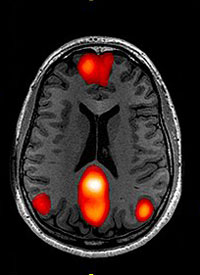In 1924, an enterprising psychiatrist named Hans Berger discovered a means to record the electrical activity of the brain. Though initially dismissed by his peers, Berger’s findings were validated by British electrophysiologists Edgar Douglas Adrian and B.H.C., Matthews in 1934 and gained widespread recognition in 1938. Berger’s electroencephalography (EEG) remains a cornerstone of modern medicine.
In 1929, Berger published a series of paper in which he postulated that the brain was always active. As evidence, he noted that his device recorded electrical oscillations even when subjects were at rest. Yet again, his contemporaries did not take his findings seriously, holding to a strict belief that the brain activated only in response to a targeted activity or thought. The invention of functional magnetic resonance imaging (fMRI) in 1990 provided the means to challenge conventional wisdom and validate Berger’s hypothesis.
 An fMRI detects variances in blood flow across brain regions with blood flow being an established proxy for neural activation. A typical experiment would commence by asking subjects to clear their minds, thereby establishing a baseline metric. Once given a focused mental task, scientists would note which areas of the brain lit up in response. To their surprise, they discovered quite a bit of brain activation in the medial frontoparietal network during the resting state. While it became less active during a targeted task (e.g., generating words), the net increase in brain energy resulting from a task proved relatively small. Understandably, this finding launched a series of inquiries into the nature and function of the newly dubbed default mode network (DMN).
An fMRI detects variances in blood flow across brain regions with blood flow being an established proxy for neural activation. A typical experiment would commence by asking subjects to clear their minds, thereby establishing a baseline metric. Once given a focused mental task, scientists would note which areas of the brain lit up in response. To their surprise, they discovered quite a bit of brain activation in the medial frontoparietal network during the resting state. While it became less active during a targeted task (e.g., generating words), the net increase in brain energy resulting from a task proved relatively small. Understandably, this finding launched a series of inquiries into the nature and function of the newly dubbed default mode network (DMN).
Self-reported data from study participants revealed that their minds wandered when demands to engage the external environment relaxed. They thought about past events or future goals and experiences. They daydreamed. They reflected on personal relationships and how they impacted their lives. These findings prompted American psychiatrist, neuroscientist, and author Judson Brewer to describe the DMN as a “narrative network” because it is caught up in self-referential processing, a.k.a. “the story of me.”
Drs. Matthew Killingsworth and Daniel Gilbert explored the frequency with which the DMN activates during waking hours. They gathered a group of test subjects with Smartphones and pinged them randomly throughout the day to capture what they were thinking and doing. It turned out that people engaged in the kind of spontaneous mind wandering associated with the DMN about as much as they were attentive to what was actually happening around them. Moreover, mind wandering was prevalent during all kinds of activities. And here’s the kicker: this behavior pattern did not make them happy.
As noted in an earlier post summarizing Dr. Mihaly Csíkszentmihályi’s book Flow: The Psychology of Optimal Experience, we are happiest when fully engrossed in voluntary activities that stretch our bodies and/or minds to accomplish something worthwhile. Such engagements take us out of “the story of me” and immerse us in a broader narrative that unfolds moment-to-moment. The DMN reasserts itself to the extent that we become bored or distracted.
Much like “flow,” Judson Brewer’s lab has shown that mindfulness meditation correlates with decreased DMN activity, notably in the posterior cingulate cortex. This effect can be induced with a relaxed focus on the breath and disrupted by distraction, a wandering mind, and trying too hard to be mindful.
Experienced meditators evidence less DMN activation and greater happiness than novices. That alone piques my interest. But I’ve surfaced another motivation to become a relaxed, proficient, consistent mindfulness practitioner. Sleep-onset insomnia has dogged me for most of my life. My head hits the pillow, and my brain starts thinking thoughts spontaneously. It can go on for hours. I now understand this phenomenon to be the inner working of my DMN. As such, I’ve started experimenting with mindfulness meditation as a bedtime routine to see if I can make a dent in my sleeplessness. The happiness boost from a less energized DMN combined with a rested body could be sheer delight.